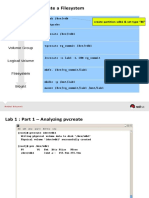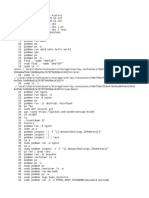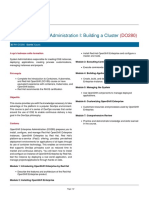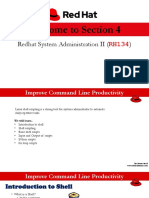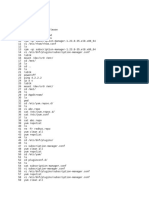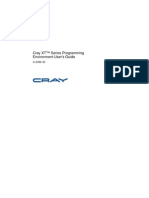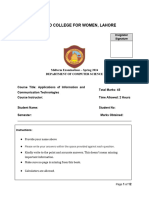RedHat - LVM Cheatsheet
RedHat - LVM Cheatsheet
Uploaded by
Anung WihadmadyatamaCopyright:
Available Formats
RedHat - LVM Cheatsheet
RedHat - LVM Cheatsheet
Uploaded by
Anung WihadmadyatamaCopyright
Available Formats
Share this document
Did you find this document useful?
Is this content inappropriate?
Copyright:
Available Formats
RedHat - LVM Cheatsheet
RedHat - LVM Cheatsheet
Uploaded by
Anung WihadmadyatamaCopyright:
Available Formats
Logical Volume Manager (LVM)
This is a quick and dirty cheat sheet on LVM using Linux, I have highlighted many of the common attributes for each command however this is not an extensive list, make sure you look up the command. With the pvs, vgs and lvs commands, the number of verboses added the more verbose information for example pvs -vvvvv
Directory and Files ## Directories /etc/lvm /etc/lvm/backup /etc/lvm/cache /etc/lvm/archive /var/lock/lvm # Files /etc/lvm/lvm.conf $HOM E/.lvm - default lvm directory location - where the automatic backups go - persistent filter cache - where automatic archives go after a volume group change - lock files to prevent metadata corruption
Directories and Files
- main lvm configuration file - lvm history Tools
lvmdump diagnostic lvmdump -d <dir> dmsetup [info|ls|status] Note: by default the lvmdump command creates a tar ball Physical Volumes pvdisplay -v pvs -v pvs -a display pvs attributes are: 1. (a)llocatable 2. e(x)ported pvscan -v scanning Note: scans for disks for non-LVM and LVM disks pvcreate /dev/sdb1 ## Create physical volume with specific UUID, used to recover volume groups (see miscellaneous section) pvcreate --uuid <UUID> /dev/sdb1 Common Attributes that you may want to use: -M 2 create a LVM 2 physical volume removing pvremove /dev/sdb1 pvck -v /dev/sdb1 checking Note: check the consistency of the LVM metadata ## do not allow allocation of extents on this drive pvchange -x n /dev/sdb1 change physical attributes Common Attributes that you may want to use: --addtag add a tag -x allowed to allocate extents -u change the uuid pvmove -v /dev/sdb2 /dev/sdb3 moving
adding
Note: moves any used extents from this volume to another volume, in readiness to remove that volume. However you cannot use this on mirrored volumes, you must convert back to non-mirror using "lvconvert -m 0" Volume Groups vgdisplay -v vgs -v vgs -a -o +devices vgs flags: #PV - number of physical devices #LV - number of configured volumes display vgs attributes are: 1. permissions (r)|(w) 2. resi(z)eable 3. e(x)ported 4. (p)artial 5. allocation policy - (c)ontiguous, c(l)ing, (n)ormal, (a)nywhere, (i)nherited 6. (c)luster scanning vgscan -v vgcreate VolData00 /dev/sdb1 /dev/sdb2 /dev/sdb3 vgcreate VolData00 /dev/sdb[123] ## Use 32M B extent size vgcreate VolData00 -s 32 /dev/sdb1 creating Common Attributes that you may want to use: -l maximum logical volumes -p maximum physical volumes -s physical extent size (default is 4M B) -A autobackup extending vgextend VolData00 /dev/sdb3 vgreduce VolData00 /dev/sdb3 reducing vgreduce --removemissing --force VolData00 vgremove VolData00 removing Common Attributes that you may want to use: -f force the removal of any logical volumes vgck VolData00 checking Note: check the consistency of the LVM metadata vgchange -a n VolData00 Common Attributes that you may want to use: change volume attributes -a control availability of volumes within the group -l maximum logical volumes -p maximum physical volumes -s physical extent size (default is 4M B) -x resizable yes or no (see VG status in vxdisplay) vgrename VolData00 Data_Vol_01 renaming note: the volume group must not have any active logical volumes vgconvert -M 2 VolData00 converting metadata type Note: vgconvert allows you to convert from one type of metadata format to another for example from LVM 1 to LVM 2 vgmerge New_Vol_Group Old_Vol_Group merging
Note: the old volumes group will be merged into the new volume group spliting vgsplit Old_Vol_Group New_Vol_Group [physical volumes] [-n logical volume name] vgimport VolData00 importing Common Attributes that you may want to use: -a import all exported volume groups ## to see if a volume has already been export use "vgs" and look at the third attribute should be a x vgexport VolData00 exporting Common Attributes that you may want to use: -a export all inactive volume groups ## Backup to default location (/etc/lvm/backup) vgcfgbackup VolData00 backing up # Backup to specific location vgcfgbackup -f /var/backup/VolData00_bkup VolData00 Note: the backup is written in plain text and are by default located in /etc/lvm/backup vgcfgrestore -f /var/backup/VolData00_bkup VolData00 Common Attributes that you may want to use: restoring -l list backups of file -f backup file -M metadataype 1 or 2 vgimportclone /dev/sdb1 cloning Note: used to import and rename duplicated volume group vgmknodes VolData00 special files Note: recreates volume group directory and logical volume special files in /dev Logical Volumes lvdisplay -v lvdisplay --maps lvs -v lvs -a -o +devices ## lvs commands for mirror volumes lvs -a -o +devices lvs -a -o +seg_pe_ranges --segments display lvs attributes are: 1. volume type: (m)irrored, (M )irrored without initail sync, (o)rigin, (p)vmove, (s)napshot, invalid (S)napshot, (v)irtual, mirror (i)mage mirror (I)mage out-of-sync, under (c)onversion 2. permissions: (w)rite, (r)ead-only 3. allocation policy - (c)ontiguous, c(l)ing, (n)ormal, (a)nywhere, (i)nherited 4. fixed (m)inor 5. state: (a)ctive, (s)uspended, (I)nvalid snapshot, invalid (S)uspended snapshot, mapped (d)evice present with-out tables, mapped device present with (i)nactive table 6. device (o)pen (mounted in other words) lvscan -v lvmdiskscan ## plain old volume lvcreate -L 10M VolData00 ## plain old volume but with a specific name web01 lvcreate -L 10M -n web01 VolData00 display mirror volumes
scanning
## plain old volume but on a specific disk lvcreate -L 10M VolData00 /dev/sdb1 ## a striped volume called lvol1 (note the captial i for the stripe size) lvcreate -i 3 -I 32 -L 24M -n lvol1 vg01 ## M irrored volume creating lvcreate -L 10M -m1 -n data01 vg01 ## M irrored volume without a mirror log file lvcreate -L 10M -m1 --mirrorlog core -n data01 vg01 Common Attributes that you may want to use: -L size of the volume [kKmM gGtT] -l number of extents -C contiguous [y|n] -i stripes -I stripe size -m mirrors --mirrorlog -n volume name
lvextend -L 20M /dev/VolData00/vol01 Common Attributes that you may want to use: -L size of the volume [kKmM gGtT] -l number of extents -C contiguous [y|n] -i stripes extending -I stripe size Note: you can extend a ext2/ext3 filesystem using the "resize2fs" or "fsadm" command fsadm resize /dev/VolData01/data01 resize2fs -p /dev/mapper/VolData01-data01 [size] The -p option displays bars of progress while extendingthe filesystem
lvreduce -L 5M /dev/VolData00/vol01 lvresize -L 5M /dev/VolData00/vol01 reducing/resizing Note: rounding will occur when extending and reducing volumes to the next extent (4M B by default), you can use resize2fs or fsadm to shrink the filesystem fsadm resize /dev/VolData01/data01 [size] resize2fs -p /dev/mapper/VolData01-data01 [size] removing adding a mirror to a nonmirrored volume lvremove /dev/VolData00/vol01 lvconvert -m1 --mirrorlog core /dev/VolData00/vol01 /dev/sdb2
lvchange -a n /dev/VolData00/vol01 Common Attributes that you may want to use: -a availability -C contiguous [y|n]
change volume attributes
renaming snapshotting
lvrename /dev/VolData00/vol_old /dev/VolData00/vol_new lvcreate --size 100M --snapshot -name snap /dev/vg01/data01 Miscellaneous
Simulating a disk failure
dd if=/dev/zero of=/dev/sdb2 count=10
## check volume, persume /dev/sdb2 has failed lvs -a -o +devices # remove the failed disk from the volume (if not already done so) , this will convert volume into a non-mirrored volume vgreduce --removemissing --force VolData00 ## replace the disk physically, remember to partion it with type 8e fdisk /dev/sdb reparing a failed mirror no LVM corruption ........ ## add new disk to LVM pvcreate /dev/sdb2 ## add the disk back into volume group vgextend VolData00 /dev/sdb2 ## mirror up the volume lvconvert -m1 --mirrorlog core /dev/VolData00/vol02 /dev/sdb2 # attempt to bring the volume group online vgchange -a y VolData00 # Restore the LVM configation corrupt LVM metadata without replacing drive vgcfgrestore VolData00 # attempt to bring the volume grou online vgchange -a y VolData00 # file system check e2fsck /dev/VolData00/data01 # attempt to bring the volume group online but you get UUID conflict errors make note of the UUID number vgchange -a y VolData00 vgchange -a n VolData00 ## sometimes it my only be a logical volume problem lvchange -a y /dev/VolData00/web02 lvchange -a n /dev/Voldata00/web02 ## replace the disk physically, remember to partion it with type 8e fdisk /dev/sdb ........ corrupt LVM metadata but # after replacing the faulty drive the disk must have the previuos UUID number or you can get it from /etc/lvm directory replacing the faulty disk pvcreate --uuid <previous UUID number taken from above command> /dev/sdb2 # Restore the LVM configation vgcfgrestore VolData00 # attempt to bring the volume group online or logical volume vgchange -a y VolData00 lvchange -a y /dev/VolData00/web02 # file system check e2fsck /dev/VolData00/data01 Note: if you have backed the volume group configuration you can obtain the UUID number in the backup file by default located in /etc/lvm/backup or running "pvs -v"
For other LVM's and Array utilities see my LVM central page
You might also like
- Red Hat® Linux Automation With Ansible (RH294) : Training ProgramDocument2 pagesRed Hat® Linux Automation With Ansible (RH294) : Training ProgramKrishnaNo ratings yet
- SLE201v15 Lab Exercise 3.4Document2 pagesSLE201v15 Lab Exercise 3.4omar walidNo ratings yet
- React Native Session 1 - Intro To React NativeDocument33 pagesReact Native Session 1 - Intro To React NativeKofiNo ratings yet
- Do180 Introduction To Containers, Kubernetes, and Red Hat OpenshiftDocument13 pagesDo180 Introduction To Containers, Kubernetes, and Red Hat Openshiftanik20110% (1)
- RHEL Cluster Pacemaker CorosyncDocument12 pagesRHEL Cluster Pacemaker CorosyncShahulNo ratings yet
- RHEL Perf TuningDocument124 pagesRHEL Perf Tuningzuri_otNo ratings yet
- Rhce Lab Exam Practice Question and AnsweDocument12 pagesRhce Lab Exam Practice Question and AnsweMathavan Sundharamoorthy0% (1)
- Arduino Example - Stepper Motor Example - Discussion Forums - National InstrumentsDocument13 pagesArduino Example - Stepper Motor Example - Discussion Forums - National InstrumentsMihai BogdanNo ratings yet
- LVMLABDocument80 pagesLVMLABDario SimbanaNo ratings yet
- DRBD-Cookbook: How to create your own cluster solution, without SAN or NAS!From EverandDRBD-Cookbook: How to create your own cluster solution, without SAN or NAS!No ratings yet
- Ex 300Document11 pagesEx 300NAYEEM100% (1)
- Course Outline: Do280-Openshift Enterprise AdministrationDocument2 pagesCourse Outline: Do280-Openshift Enterprise AdministrationAshish KumarNo ratings yet
- Rhel 8 Mock Paper IDocument5 pagesRhel 8 Mock Paper Idhc14301No ratings yet
- Red Hat Enterprise Linux Automation With AnsibleDocument32 pagesRed Hat Enterprise Linux Automation With AnsiblePiya ChoudhuryNo ratings yet
- NFS Configuration On Linux RHELDocument12 pagesNFS Configuration On Linux RHELjeganNo ratings yet
- Fast Lane - RH-DO180Document3 pagesFast Lane - RH-DO180Charles WeiNo ratings yet
- RHCSADocument10 pagesRHCSACarl Anthony Yau50% (2)
- DracutDocument12 pagesDracutcarlosNo ratings yet
- Ex180 April22 Day1Document3 pagesEx180 April22 Day1smile2me2012No ratings yet
- Script Ultimate Rhcsa TrainingDocument4 pagesScript Ultimate Rhcsa Trainingaleco9No ratings yet
- Exdump 3Document5 pagesExdump 3chalapathiraoNo ratings yet
- Rche8 PDFDocument2 pagesRche8 PDFFabio Abreu0% (2)
- Red Hat Openshift Administration I: Building A Cluster: Id Rh-Do280 Durée 3 JoursDocument2 pagesRed Hat Openshift Administration I: Building A Cluster: Id Rh-Do280 Durée 3 JoursAnis BEN JEMAANo ratings yet
- Do280 Manually Scaling An OpenShift ClusterDocument2 pagesDo280 Manually Scaling An OpenShift ClusterSrinivasan100% (1)
- Highly Available iSCSI Storage With DRBD and Pacemaker: Florian HaasDocument24 pagesHighly Available iSCSI Storage With DRBD and Pacemaker: Florian HaasmacroendrixNo ratings yet
- Update Kernel Package2 - 1458767332 PDFDocument4 pagesUpdate Kernel Package2 - 1458767332 PDFsritam100% (1)
- Configure NFS Collaborative Share in RHEL 7Document16 pagesConfigure NFS Collaborative Share in RHEL 7info infoNo ratings yet
- RHCSA With KeyDocument5 pagesRHCSA With KeyjohnNo ratings yet
- RHCSADocument1 pageRHCSADuluth Markets0% (1)
- An Easy Guide To Linux-PAM - DZone Performance-NOBORRARDocument5 pagesAn Easy Guide To Linux-PAM - DZone Performance-NOBORRARpepenetNo ratings yet
- Ansible Ex407 Slides - 1531395006Document62 pagesAnsible Ex407 Slides - 1531395006Divyam PateriyaNo ratings yet
- Openstack 888Document68 pagesOpenstack 888Subbarao AppanabhotlaNo ratings yet
- Scripts RhcsaDocument3 pagesScripts RhcsaDeshfoss Deepak100% (1)
- RHCEDocument6 pagesRHCEMayank MehtaNo ratings yet
- Do280 Scaling An ApplicationDocument1 pageDo280 Scaling An ApplicationSrinivasanNo ratings yet
- AIX Boot ProcessDocument99 pagesAIX Boot ProcessBharat ThapaNo ratings yet
- Linux - Part Ii: Asad 1/1/2012Document9 pagesLinux - Part Ii: Asad 1/1/2012Asad EjazNo ratings yet
- RHCE Update PDFDocument52 pagesRHCE Update PDFPrasanth UnnikrishnanNo ratings yet
- OpenShift On AWS 170517 PDFDocument18 pagesOpenShift On AWS 170517 PDFAnonymous 2xuOMoNo ratings yet
- EX294 QuestionsDocument7 pagesEX294 Questionsbedoui marwenNo ratings yet
- DO180 - ch05s03 6Document1 pageDO180 - ch05s03 6fbfNo ratings yet
- Chapter 5 File Management: Storage Hard Disks, LVM and RAIDDocument31 pagesChapter 5 File Management: Storage Hard Disks, LVM and RAIDLethal11No ratings yet
- LinuxCBT Moni-Zab Edition Classroom NotesDocument5 pagesLinuxCBT Moni-Zab Edition Classroom NotesFaisal Saeed SaeedNo ratings yet
- ConfigMaps - Setting ConfigMaps From The Oc CLIDocument4 pagesConfigMaps - Setting ConfigMaps From The Oc CLImailrobertbNo ratings yet
- Samba On AIXDocument14 pagesSamba On AIXChristian FisherNo ratings yet
- rh442 NotesDocument26 pagesrh442 Notesindrajitnandi8161No ratings yet
- T5-Linux Performance TuningDocument52 pagesT5-Linux Performance TuningjacobNo ratings yet
- EX300 Redhat Exam Prep Cheat SheetDocument13 pagesEX300 Redhat Exam Prep Cheat Sheetbtkk zztbNo ratings yet
- DO374Document100 pagesDO374Leonid ST100% (1)
- RH134Document69 pagesRH134Sherif MostafaNo ratings yet
- Rhca Certification FQADocument2 pagesRhca Certification FQAHardeep Singh TiwanaNo ratings yet
- Openshift Training CommandDocument3 pagesOpenshift Training CommandPRIYABRAT RATHNo ratings yet
- 317 Ansible Ad Hoc Studyguide 1554293098Document13 pages317 Ansible Ad Hoc Studyguide 1554293098Jamshid AzizovNo ratings yet
- RH342 Study Sheet: System BootDocument5 pagesRH342 Study Sheet: System BootdchikumbaNo ratings yet
- Ansible Cheat SheetDocument8 pagesAnsible Cheat SheetVu Van ThanNo ratings yet
- DO280 Course OutlineDocument3 pagesDO280 Course OutlineAslam AnsariNo ratings yet
- NmcliDocument4 pagesNmcliziblurNo ratings yet
- SLE201v15 Lab Exercise 5.1Document2 pagesSLE201v15 Lab Exercise 5.1omar walidNo ratings yet
- Suse Linux Administration Guide PDFDocument292 pagesSuse Linux Administration Guide PDFMichael LeoneNo ratings yet
- Evolution of Operating SystemsDocument3 pagesEvolution of Operating Systems4gen_3No ratings yet
- Code Injection and HookingDocument23 pagesCode Injection and Hooking21st TechNo ratings yet
- Chapter 3 Application SoftwareDocument21 pagesChapter 3 Application SoftwarefuadmisbahNo ratings yet
- Poweredge-T330 - User's Guide2 - En-Us PDFDocument90 pagesPoweredge-T330 - User's Guide2 - En-Us PDFpitycu90No ratings yet
- MediaTek Helio P90 Infographic PDFDocument1 pageMediaTek Helio P90 Infographic PDFPrasetyo Aji.pNo ratings yet
- Create A VB6 Grid Control Your Users Can ModifyDocument4 pagesCreate A VB6 Grid Control Your Users Can Modifychoey13No ratings yet
- LogDocument12 pagesLogJunior PratamaNo ratings yet
- 2.2.1.12 Lab - Windows Task ManagerDocument11 pages2.2.1.12 Lab - Windows Task ManagerKwimpal NychaNo ratings yet
- Module 1Document115 pagesModule 1Anonymous thOs8HQwNo ratings yet
- Product Manual & Firmware: Antminer Bitdeer Blog SupportDocument2 pagesProduct Manual & Firmware: Antminer Bitdeer Blog SupportFranciscoMondazziNo ratings yet
- DumpstateDocument9 pagesDumpstateCorina BenaNo ratings yet
- 06-239 05 WatchMan Software ManualDocument16 pages06-239 05 WatchMan Software ManualususariNo ratings yet
- PSLUC Lab Manual Without Test CasesDocument129 pagesPSLUC Lab Manual Without Test CasesVaishnav Shankar Bhuvan SilaparasettyNo ratings yet
- ECEE2 - Lecture 3 - FlowchartingDocument3 pagesECEE2 - Lecture 3 - FlowchartingJheZz MasinsinNo ratings yet
- Field Manager ManualDocument83 pagesField Manager Manualgemin0204No ratings yet
- File 1Document133 pagesFile 1Viraj n RajNo ratings yet
- 21Document149 pages21Kubun Ginta GintingNo ratings yet
- Cray Series Programming Environment Users GuideDocument233 pagesCray Series Programming Environment Users Guidecscutt100% (1)
- Pro Tools Reference Guide v10 73478Document1,288 pagesPro Tools Reference Guide v10 73478datttNo ratings yet
- Switch CaseDocument18 pagesSwitch Caseranjit sahaNo ratings yet
- Introduction To The PIC18 Introduction To The PIC18 Microcontroller Microcontroller Microcontroller MicrocontrollerDocument50 pagesIntroduction To The PIC18 Introduction To The PIC18 Microcontroller Microcontroller Microcontroller MicrocontrolleranjanbsNo ratings yet
- Verilog Prep MaterialDocument11 pagesVerilog Prep MaterialSangeetha BajanthriNo ratings yet
- Ismart Training Manual v3Document86 pagesIsmart Training Manual v3Aidan ReillyNo ratings yet
- Dili Institute of TechnologyDocument61 pagesDili Institute of TechnologyDionisio M SoaresNo ratings yet
- Manuel Service LG ARIA SOHO LDK100 PDFDocument51 pagesManuel Service LG ARIA SOHO LDK100 PDFAtabji SamirNo ratings yet
- 12 Man Sdref Ind780 enDocument192 pages12 Man Sdref Ind780 enAhmad HamoudaNo ratings yet
- Phantom 2Document14 pagesPhantom 2Nacho RoccaNo ratings yet
- AICT - Mid Spring 2024 - KeyDocument12 pagesAICT - Mid Spring 2024 - Keyzinniamalik222No ratings yet








